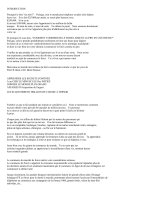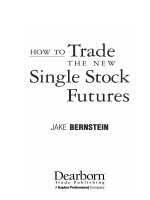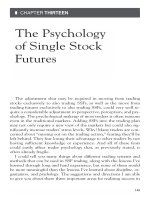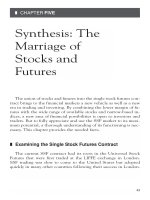Kiss forex how to trade ichimoku
Bạn đang xem bản rút gọn của tài liệu. Xem và tải ngay bản đầy đủ của tài liệu tại đây (4.37 MB, 72 trang )
KISS FOREX
How to Trade
ICHIMOKU System’s
profitable Signals
Printing out more than one copy -or distributing it electronically -is prohibited by international and U.S.A.
copyright laws and treaties, and would subject the purchaser to penalties of up to $100,000 PER COPY
distributed.
Copyright © 2013-2018 by SIOLEENO INV. CO LTD
All rights reserved. No part of this publication may be reproduced or
transmitted in any form or by any means, electronic, or mechanical, including
photocopying, recording, or by any information storage and retrieval system.
Published by:
SIOLEENO INV. CO LTD
9 Arch. Makariou Ave., Lazaros Center, 1st Floor, Suite 107,
6307 - Larnaka- CYPRUS
Forex Training Website:
E-Mail:
Online Forex Magazine :
To my Man for being my Alter Ego.
TABLE OF CONTENTS
Introduction
1. Five Lines to Forex Riches
2. Talking Cloud
3. Petting a Cat or a Tiger?
4. Entry/Exit Signals
5. Ichimoku Magic
6. Make it happen!
7. Giving Back
Resources
Legal Disclaimer
Introduction
It is a fact that human brain responds better to organized
and recognizable shapes than to chaotic images. Price Action Charts look chaotic unless
we are trained to spot the “waves” or we use a System that enables us to decode
“chaos”.
During my early years of Trading FOREX, I had no idea that an alternative way of
looking at my charts might have the power of giving me a better understanding of
Market’s Condition at any time.
ICHIMOKU KINKO HYO is such a System. The more I use it and integrate it to my
trading routine, the more confident I feel.
They say that setting your Exit Point –or Take Profit Target – is even more important
than knowing when and how to Enter the Market. That’s true. ICHIMOKU helps you
notice Market’s “intentions” and adjust your trade accordingly. As its name implies,
ICHIMOKU helps you understand where Market is heading showing its “Equilibrium
Status at a glance”.
It applies on all time-frames and it’s been especially designed for Trending Markets
where it’s extremely powerful when used on big time-frames (H4, Daily, Weekly).
Thanks to INTERNET, the Capital Markets with a daily turnover that touches 6 trillion
USD, are accessible to any investor. The potential is huge but only to those who will
educate themselves.
-Is FOREX Trading easy?
-No!
-Is it simple?
-Yes, if you know what you’re doing.
-Why do I love ICHIMOKU more than any other Trading System or tool I know?
-Because of its simplicity.
-Why is simplicity so important?
-Because it leverages your results without exhausting your physical energy reserves.
Feeling comfortable when trading is essential.
Success is the very boring process of doing repeatedly what is working. To my opinion,
once you familiarize yourself with ICHIMOKU System, you’ll hardly ever need any
other Trading Tool in order to be consistently profitable with FOREX.
I’m not a Technical Analyst or an Expert of any kind. I’m just a FOREX Trader in a
constant learning process and I’ll gladly share with you what I have found profitable
again and again. This book is part of my effort to scratch the surface of ICHIMOKU
Trading “iceberg” sharing with you my way of interpreting its countless signals. Once
you familiarize yourself with it, possibilities are literally limitless.
Following my favorite Paretto’s Principle, I’m sharing with you this 20% of my
ICHIMOKU SYSTEM Knowledge, which keeps giving me 80% of profitable results.
This Book is part of the FXholic Series.
VIDEOS with my Ichimoku trades setups you can find at
and detailed posts you can find at Forexid.com You
are also welcome to follow me on Instagram where I often post my Charts @fxholic.
English is not my mother language, so your tolerance will be appreciated.
Kind Regards
Sofia Stavropoulou
1. Five Lines to Forex Riches
ICHIMOKU KINKO HYO is a Japanese Trading System especially designed for
Trending Markets, which a Japanese newspaper Man, Goichi Hosoda, started
developing well before the World War II with the assistance of many students who
meticulously plotted the charts and graphs necessary for backtesting analysis at the
time. It took more than twenty years of testing for the System to be completed and
finally released to the public in 1968.
Since then, ICHIMOKU KINKO HYO which translates into “Equilibrium Chart at a
glance” has been used with great success from Asian Traders in all kinds of tradeable
instruments, while it remained a sort of a well kept “secret” to the Eastern World till
1990.
After its components and mechanics started being translated and explained in English, a
constantly growing number of Western Markets Traders adopted it.
Its uniqueness lies at the fact that ICHIMOKU uses KUMO –the cloud- to represent the
Market’s Equilibrium Zone where various data are combined to depict Resistance and
Support as Kumo’s upper and lower boundaries.
Figure 1. Ichimoku System
In a nutshell, trader should look to enter Long when Price moves above the Kumo, if
certain conditions are met and Short if Price moves below the Kumo, while staying out
of the Market would be advisable while Price moves inside the Kumo in a zone that
stands for absolute Equilibrium or Stasis.
The way Equilibrium as well as Support and Resistance are shown by ICHIMOKU, is
quite unconventional and a lot less prone to false Signals than the traditional Charting
tactics of drawing Trendlines and making trading decisions when they’re being broken
by price action.
Price’s relationship with the Kumo –defined by two lines- as well as with the other
three lines of the System, gives a plethora of information regarding Market’s
Momentum, volatility and directional biases in a simple visual manner that even a five
years old child can easily comprehend. Trader gets Market’s sentiment as it evolves in
the near future compared to its past status.
Although each one of ICHIMOKU System’s Five Elements reflects a distinct trait of
human behavior –always being expressed through cyclical patterns of psychology kept
close to equilibrium zone or pushed away from it before it returns to the equilibrium
state again- which is the backbone of Market’s Sentiment as believed by Goichi
Hosoda, they should be interpreted as integral parts of the System.
Therefore, we can safely say that ICHIMOKU is a “stand alone” Trading System.
•
Tenkan Sen
Figure 2. Tenkan Sen (red line)
Tenkan Sen is calculated by finding the Average of the (HIGHEST HIGH + LOWEST
LOW)/2 for the past 9 periods. By measuring the price’s EXTREMES instead of its
closing points –which is what a 9 SMA would do- ICHIMOKU System gives a better
sense of price’s Equilibrium Status as you can see in Figure 3.
Figure 3. Tenkan Sen compared to 9-SMA
Tenkan Sen therefore provides a more reliable “Support” than 9-SMA (Simple Moving
Average) and in trending Markets literally “contains” the price action.
Tenkan Sen’s slope reflects the degree of trend’s momentum. The steepest its upwards
angle, the bigger the Bullish Momentum is. On the other hand, the steepest Tenkan Sen’s
downward angle, the stronger the Bearish Momentum is. Of course we can’t base our
trading decisions on Tenkan Sen alone, but this is a brief description of this line’s role
in the ICHIMOKU System.
•
Kijun Sen
Kijun Sen is calculated by finding the average of (HIGHEST HIGH + LOWEST
LOW)/2 for the past 26 periods. Because it’s based on a longer period of time, its role
as Support or Resistance becomes more significant than Tenkan Sen’s. Every time
Kijun Sen forms a flat line it means that price is at the same levels as the last 26 periods
Average. When price goes above past 26 periods Average, Kijun Sen starts trending
upwards and when it goes below, Kijun Sen starts trending downwards. It is observed
that Kijun Sen’s relationship with Price-Action manifests a periodical pattern of
“rubber effect”. Since Kijun Sen represents an Equilibrium Level, Price tends to return
to it after it has trended away for a short period of time.
Figure 4. Kijun Sen (blue line)
•
Chikou Span
Figure 5. Chinkou Span (green line)
Chikou Span is the current closing price shifted 26 periods backwards (into the past)
What this unique ICHIMOKU Line actually does is adding perspective to our view of
the Market helping us filter out trading decisions with an instant comparison of current
price action to that of the recent past, thus validating the current trend.
•
The KUMO
Figure 6. KUMO (the cloud)
The KUMO (meaning cloud in Japanese) is formed by the two lines : Senkou Span A
and Senkou Span B. It is BULLISH when Senkou Span A is on top of it and Senkou Span
B is below and it is BEARISH when the opposite happens.
•
Senkou Span A
Senkou Span A is calculated by the average of Tenkan Sen and Kijun Sen [(TENKAN
SEN + KIJUN SEN)/2 ]time-shifted forward (into the future) 26 periods. Therefore it
is a fast moving line that mainly shows where the current Support or Resistance levels
are and price’s relationship with them in a visual manner that keeps price action and
Support/Resistance level separate facilitating the eye to get a clearer view.
Figure 7. Senkou Span A
•
Senkou Span B
Figure 8. Senkou Span B
Senkou Span B is calculated by (HIGHEST HIGH + LOWEST LOW)/2 for the past 52
periods time-shifted forwards (into the future) 26 periods. Essentially on a daily chart,
this slow-line stands for the “projection” of price extremes’ average for the past two
months, one month ahead. (Its analogue happens with other time-frames). Look at it as a
double-time Kijun Sen shifted in the future for 26 periods. While Senkou Span A
reminds me of the “stitch” on the “good” side of the fabric (Kumo), Senkou Span B is
the “stitch” that once turned brings the “wrong” side of the fabric (Kumo) up. Because
Senkou Span A is the fast-line, it faces price action most of the time either on the Bullish
or Bearish territory, while Senkou Span B, being the slow-line, rarely faces price action
and that happens only on KUMO Breakouts.
Figure 9. Senkou Span A , Senkou Span B and Momentum
The two lines, Senkou Span A and Senkou Span B being parts of the KUMO, are
interconnected giving us a lot of information on Market’s current condition. For a new
Kumo to be created, these two lines must cross. If Senkou Span A is above Senkou Span
B, the KUMO is Bullish, if Senkou Span A is below Senkou Span B, KUMO is Bearish.
The Vertical Distance between the two lines gauges momentum, while their angles alone
or combined lead us to solid conclusions about Market’s dynamics. Senkou Span A and
Senkou Span B are the variants that cause KUMO’s morphology. Learning to interpret
this morphology is of essential importance to a trader’s success.
1. Talking Cloud
ICHIMOKU KINKO HYO is definitely a great System to be used on all Markets, all
time-frames and literally every Market Condition, but since we want to make our life
simpler, it’s better to use it on Trending Markets, since that’s why it was designed since
the beginning.
Practice makes perfect so try to ALWAYS look at a pair through all time-frames using
ICHIMOKU. You’ll understand what’s the major trend and at which stage Market
currently is. Is it a strong impulsive wave to the direction of the main trend as bigger
time-frames tell us or is it a minor corrective move against main trend’s direction? Is
the corrective move happening on a small time-frame or is it unfolding on H4 or Daily
Chart?
-How does ICHIMOKU tell us about the main trend at one glance?
-We start by looking at the Monthly Chart of the pair
Figure 10. AUDUSD, Monthly Chart, 28/03/2013
-Next we go to the Weekly Chart of the pair
Figure 11. AUDUSD, Weekly Chart, 28/03/2013
-Then we move on to the Daily Chart
Figure 12. AUDUSD, Daily Chart, 28/03/2013
-Then we look at the H4 Chart of the pair
Figure 13. AUDUSD, H4 Chart, 28/032013 @23:54 GMT
- H1 Chart comes next
Figure 14. AUDUSD, H1 Chart, 29/03/2013 @00:02 GMT
-We end up at the M15 Chart from which we’ll setup our trade and monitor it.
Figure 15. AUDUSD, M15 Chart, 29/03/2013, @00:11 GMT
Did you notice the relationship between KUMO morphology and the price action? In
case you didn’t have a look at the following images.
Figure 16. See how KUMO's upper/lower lines reflect Price's upper/lower outline?
See how KUMO imitates price’s lower outline with its lower border which here is
Senkou Span B.
Practice observing both upper and lower KUMO Borders as price action progresses in
time. Soon you’ll be able to “catch” the next big move by noticing the distinct details of
Kumo’s morphology, either being edges, tops, curves or indentations.
When price moves above KUMO, Market’s environment is generally bullish. When
price moves below KUMO, it’s bearish. When price moves inside KUMO, there is
actually stasis, due to the equilibrium represented by the KUMO.
If you’re in a trending Market with a bullish environment on the H4 Chart, but you see
price dipping down towards testing KUMO border –Senkou Span A in this case- there
are three possible scenarios :
1. Bullish Scenario A: in this case, price starts moving sideways inside the
KUMO for a while, we watch that after Tenkan Sen/Kijun Sen Bearish
Crossover, Kijun Sen is now flat and so is KUMO’s lower border (Senkou Span
B) while KUMO’s upper border (Senkou Span A) has curved downwards. A few
candlesticks later, price manages to emerge out of the KUMO, crosses with
Tenkan Sen and finally slips above Kijun Sen resuming its upward course
stronger than before. That means, Bulls were just taking some profits closing a
few positions before they push the price higher.
2. Bullish Scenario B: in this case, price keeps moving sideways, while Kijun
Sen remains flat and so does KUMO lower border –Senkou Span B-. Then, price
manages to penetrate the KUMO and break out of it but as this happens, bearish
move runs out of steam and we see a bullish candle forming followed by more
that lead to a new KUMO breakout which is bullish this time and price resumes
upwards with steel determination. That means, that Bulls needed to catch their
breath after having climbed all those previous stairs, just like a person who is
climbing a stair upwards, the more floors they have to pass up the more breaks
they need to make on their way up.
3. Bearish Scenario : in this case, price continues moving sideways for a few
more candles inside KUMO, when suddenly a strong bearish candle plunges
downwards into a Bearish KUMO Breakout from the other side of the cloud.
Before that happens, you’ll see Kijun Sen suddenly sloping downwards and
that’s a sign you should close your Long Position minimizing your losses and
open only Short Positions. If price found the strength to move through the KUMO
fighting against its powerful support, it means that Bears are in control of the
Market.
Another essential KUMO element that adds great importance to the ICHIMOKU
SYSTEM’s efficacy confirming its “stand-alone”value to the trader, is the visual way it
represents Market’s Volatility and Price’s Momentum being in the same pane as price.
If you look closely to the KUMO’s “fabric”, you’ll notice that it is made of thin dotted
vertical lines that have the color of the line that is on top. So if Senkou Span A is on top,
therefore we have a Bullish Kumo, thin dotted vertical lines run downwards from
Senkou Span A TO Senkou Span B. In a Bearish Kumo, thin dotted vertical lines have
the Senkou Span B color and run downwards from Senkou Span B TO Senkou Span A.
This “fabric” made from thin dotted vertical lines, actually shapes a very vivid and
definitely not linear histogram. For every new price candlestick, a new “thread” is
added to this fabric. Thread’s length –height- depends on price’s momentum and
Market’s volatility. Momentum is practically expressing Market’s directional biases. It
shows whether Bulls or Bears win the tug-war. More Bullish candlesticks than Bearish
show Bullish Momentum. Volatility expresses transactions volume and reflects to the
candlesticks size (range).
Figure 17. AUDUSD, H4 Chart : are we going to have a Bullish or Bearish Scenario?
On Figure 17 above, watch how the leading KUMO (the part of KUMO which is in the
future) gets thinner as Volatility decreases –because price moves sideways in a
consolidation mode forming small candlesticks- and as Bullish Momentum decreases
too. Just an in MACD Oscillator, Bullish Momentum is measured by the thickness of
the Histogram Above Zero Line, in ICHIMOKU System, Bullish Momentum is measured
by the thickness of Bullish KUMO, translated into the distance between the upper line –
Senkou Span A- and lower line –Senkou Span B. As leading Kumo turns into Bearish,
after Senkou Span A crosses with Senkou Span B and plunges downwards, we now see
Bearish Momentum increasing as Bearish Kumo builds up its “body” and Senkou Span
A –lower border- hangs below Senkou Span B –upper border.
Another KUMO element that should always be checked before you make any trading
decision, is angle.
The part of the KUMO you should always have your eyes nailed on is the LEADING
KUMO, the one also called “future KUMO”. Watching every single tiny detail that
changes on the LEADING KUMO, can make all the difference between a loser and a
winner trader.
We can observe the following types of LEADING KUMO Angles and Shapes :
1. Leading KUMO forms Strong Upward or Downward Angle with its
top/bottom Edge being steep and sharp.
Figure 18. USDJPY Weekly Chart on March 31th 2013 showing a steep and sharp upward KUMO Angle
Figure 19. EURGBP, H4 Chart where we see a Bearish Kumo angling downwards with a sharp edge.
What does this mean?
-Strong Trend.
How do we confirm it?
-Chikou Span is above past price action in Bullish Trend and below past price
action in Bearish Trend. Preferably, Chikou Span is angling or vertical.
Additionally we can superimpose 65 and 200 EMA’s to our Chart, although that
would be the kind of excess my late grandma used to laugh about saying “don’t
use two wash-machines to place the washboard over”. Last but not least, pay
attention to the horizontal distance between price and KUMO. The bigger the
stronger newborn trend will be.
Figure 20. 65 and 200-EMA's give a Bullish Confirmation.
Figure 21. 65-200 EMA's giving Bearish Confirmation angling downwards along with Bearish KUMO
2. Leading KUMO’s body is angling Upward or Downward but its top/bottom
Edge is curved.









